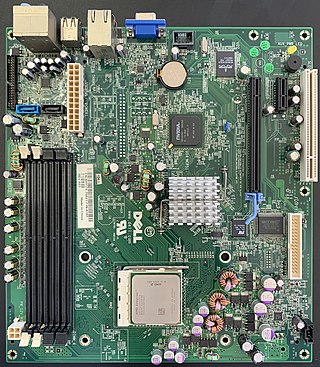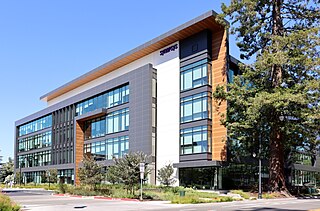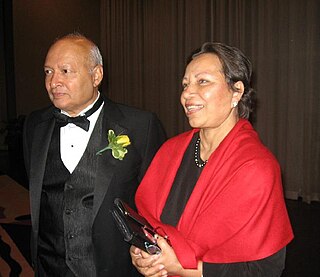
A field-programmable gate array (FPGA) is a type of configurable integrated circuit that can be repeatedly programmed after manufacturing. FPGAs are a subset of logic devices referred to as programmable logic devices (PLDs). They consist of an array of programmable logic blocks with a connecting grid, that can be configured "in the field" to interconnect with other logic blocks to perform various digital functions. FPGAs are often used in limited (low) quantity production of custom-made products, and in research and development, where the higher cost of individual FPGAs is not as important, and where creating and manufacturing a custom circuit wouldn't be feasible. Other applications for FPGAs include the telecommunications, automotive, aerospace, and industrial sectors, which benefit from their flexibility, high signal processing speed, and parallel processing abilities.

Computer engineering is a branch of electrical engineering that integrates several fields of electrical engineering, electronics engineering and computer science required to develop computer hardware and software. Computer engineering is referred to as Electrical and Computer engineering OR Computer Science and Engineering at some universities

Synopsys, Inc. is an American electronic design automation (EDA) company headquartered in Sunnyvale, California, that focuses on silicon design and verification, silicon intellectual property and software security and quality. Synopsys supplies tools and services to the semiconductor design and manufacturing industry. Products include tools for logic synthesis and physical design of integrated circuits, simulators for development, and debugging environments that assist in the design of the logic for chips and computer systems. As of 2023, the company is a component of the Nasdaq-100 and S&P 500 indices.

A mixed-signal integrated circuit is any integrated circuit that has both analog circuits and digital circuits on a single semiconductor die. Their usage has grown dramatically with the increased use of cell phones, telecommunications, portable electronics, and automobiles with electronics and digital sensors.

Thomas Kailath is an Indian born American electrical engineer, information theorist, control engineer, entrepreneur and the Hitachi America Professor of Engineering emeritus at Stanford University. Professor Kailath has authored several books, including the well-known book Linear Systems, which ranks as one of the most referenced books in the field of linear systems.
Actel Corporation was an American manufacturer of nonvolatile, low-power field-programmable gate arrays (FPGAs), mixed-signal FPGAs, and programmable logic solutions. It had its headquarters in Mountain View, California, with offices worldwide. In November 2010, Microsemi acquired Actel for $430 million.

An active-pixel sensor (APS) is an image sensor, which was invented by Peter J.W. Noble in 1968, where each pixel sensor unit cell has a photodetector and one or more active transistors. In a metal–oxide–semiconductor (MOS) active-pixel sensor, MOS field-effect transistors (MOSFETs) are used as amplifiers. There are different types of APS, including the early NMOS APS and the now much more common complementary MOS (CMOS) APS, also known as the CMOS sensor. CMOS sensors are used in digital camera technologies such as cell phone cameras, web cameras, most modern digital pocket cameras, most digital single-lens reflex cameras (DSLRs), mirrorless interchangeable-lens cameras (MILCs), and lensless imaging for, e.g., blood cells.

Richard "Dick" Francis Lyon is an American inventor, scientist, and engineer. He is one of the two people who independently invented the first optical mouse devices in 1980. He has worked in signal processing and was a co-founder of Foveon, Inc., a digital camera and image sensor company.

Aart J. de Geus is a co-founder and executive chair of Synopsys Inc., where he was CEO until January 2024.
Thomas H. Lee is a professor in the Dat Stanford University. Lee's research focus has been on gigahertz-speed wireline and wireless integrated circuits built in conventional silicon technologies, particularly CMOS; microwave; and RF circuits.
Microsemi Corporation was an Aliso Viejo, California-based provider of semiconductor and system solutions for aerospace & defense, communications, data center and industrial markets.
The IEEE Robert N. Noyce Medal is a science award presented by the IEEE for outstanding contributions to the microelectronics industry. It is given to individuals who have demonstrated contributions in multiple areas including technology development, business development, industry leadership, development of technology policy, and standards development. The medal is named in honour of Robert N. Noyce, the co-founder of Intel Corporation. He was also renowned for his 1959 invention of the integrated circuit. The medal is funded by Intel Corporation and was first awarded in 2000.

Faysal A. Sohail is an American venture capitalist and Managing Director at Presidio Partners in San Francisco. Sohail was a co-founder of Silicon Architects and on the founding team of Actel Corporation, two influential companies in the computer chip industry. Sohail serves as the Chairman of the Advisory Board of InoBat Auto, a European electric vehicle battery producer. In addition to that, he holds the position of Chairman of the Board at Our Next Energy (ONE), and serves as a board member for both Ascend Elements, and Wildcat Discovery Technologies, focusing on the sustainable energy sector.

Prabhakar Raghavan is a business executive and former researcher of web information retrieval. He currently holds the role of Chief Technologist at Google. His research spans algorithms, web search and databases. He is the co-author of the textbooks Randomized Algorithms with Rajeev Motwani and Introduction to Information Retrieval.
Kwabena Adu Boahen is a Ghanaian-born Professor of Bioengineering and Electrical Engineering at Stanford University. He previously taught at the University of Pennsylvania.
A nanoelectromechanical (NEM) relay is an electrically actuatedswitch that is built on the nanometer scale using semiconductor fabrication techniques. They are designed to operate in replacement of, or in conjunction with, traditional semiconductor logic. While the mechanical nature of NEM relays makes them switch much slower than solid-state relays, they have many advantageous properties, such as zero current leakage and low power consumption, which make them potentially useful in next generation computing.

Roger Thomas Howe is the William E. Ayer Professor of Electrical Engineering at Stanford University. He earned a B.S. degree in physics from Harvey Mudd College and M.S. and Ph.D. degrees in electrical engineering from the University of California, Berkeley in 1981 and 1984, respectively. He was a faculty member at Carnegie-Mellon University from 1984-1985, at the Massachusetts Institute of Technology from 1985-1987, and at UC Berkeley between 1987-2005, where he was the Robert S. Pepper Distinguished Professor. He has been a faculty member of the School of Engineering at Stanford since 2005.
Boris Murmann is a professor in the Department of Electrical Engineering at University of Hawaii.

Andrea Goldsmith is an American electrical engineer and the Dean of Engineering and Applied Science at Princeton University. She is also the Arthur LeGrand Doty Professor of Electrical Engineering at Princeton. She was previously the Stephen Harris Professor in the School of Engineering at Stanford University, as well as a faculty affiliate at the Stanford Neurosciences Institute. Her interests are in the design, analysis and fundamental performance limits of wireless systems and networks, and in the application of communication theory and signal processing to neuroscience. She also co-founded and served as chief technology officer of Plume WiFi and Quantenna Communications. Since 2021, she has been a member of the President’s Council of Advisors on Science and Technology (PCAST).

Helmy Eltoukhy is an American scientist and a businessperson who co-founded startups Avantome and Guardant Health. He is best known for his contributions to genomics, semiconductor DNA sequencing, and personalized medicine. His startups were acquired by Illumina in 2008. Avantome was founded to develop and commercialize semiconductor-based DNA sequencing, during the race for the $1,000 genome. Guardant Health was founded to pioneer non-invasive liquid biopsy approaches for cancer diagnosis, monitoring, personalized medicine treatment, and research.













